Women’s bodies are incredible and the transformative process of pregnancy is no walk in the park. Gone are the days when expecting women were seen as fragile and weak (thankfully!); the benefits of prenatal exercise are now well-documented for both baby and mom.
The American Congress of Obstetricians and Gynecologists (ACOG) notes that although a woman’s body will undergo enormous change during the pre- and postnatal periods, “exercise has minimal risks and has been shown to benefit most women,” noting that women with healthy pregnancies should be encouraged to participate in exercise before, during, and after their pregnancies. Does that mean that any and all exercise gets the green light during pregnancy? Not necessarily! The changes that occur within a woman’s body due to her growing baby mean that not all exercise is created equal during this chapter. Here are five considerations to make when you’re sweating with a bump:
-
It’s Not You; It’s Me!
Often, the concern about exercise during pregnancy is one for the baby, but what many women don’t realize is that, with a few exceptions, almost all exercise is safe for baby. Our bodies do a great job of creating an environment where baby is well-protected from the jostling and jumping that you may be doing. If you are engaging in activities with a high risk of falling, or if you’re experiencing a high-risk pregnancy, the risk to baby is increased but most women experiencing a low-risk pregnancy can exercise to their heart’s content without having to worry about negatively affecting their growing babies.
ACOG reminds us that pregnant women should be sure to drink plenty of fluids, avoid overheating, wear a supportive sports bra, and avoid staying in the same position for long durations of time. While women were previously informed to never lie on their backs, the most recent recommendation is for women to avoid the supine (lying flat on their back) position only if they feel symptomatic, including feelings of lightheadedness, nausea, dizziness, rapid heartrate, or profuse sweating.
Women are not always informed, and, therefore, don’t always consider how all of the activity is affecting their bodies! High impact and high intensity exercise may be too overwhelming for parts of our body to be able to handle, especially during the later stages of pregnancy, which leads us to our next consideration…
-
The Core of the Matter
You don’t need an academic background in anatomy to figure out that a woman’s torso and pelvis are areas that change significantly during pregnancy! The system of muscles most impacted by the developing fetus is our deep core system, comprised of our diaphragm, transverse abdominis, spinal stabilizers, and our pelvic floor muscles. During pregnancy, the demands placed on these muscles (and the surrounding connective tissue) can alter their ability to function optimally.
So, does that mean that we lay off all core exercise during pregnancy? Definitely not, as the “core” is always functioning and pregnancy is arguably one of the more critical times during a woman’s life to focus on stability and strength in our centers. The best “core” exercises during pregnancy are ones that train the body to maintain stability, and prioritize the automatic functioning of this deep system. Trade the crunches, sit ups, and potentially even planks for exercises like single-sided carries, and chops. Not only are they a bigger bang for your buck, working a variety of muscle groups, but they also help train our body to complete movements we do in “real life” frequently.
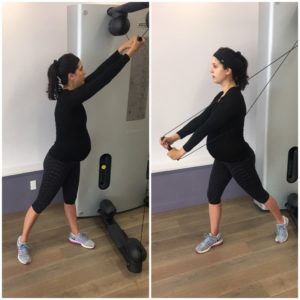 Standing Cable Chop – Begin with hands on cable, body rotated slightly towards arms (as seen in the left photo). On exhale, pull the cable towards the outside hip, pivoting the foot and rotating with the cable (as seen in the right photo). [Complete both sides.]
Standing Cable Chop – Begin with hands on cable, body rotated slightly towards arms (as seen in the left photo). On exhale, pull the cable towards the outside hip, pivoting the foot and rotating with the cable (as seen in the right photo). [Complete both sides.]
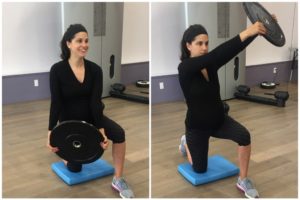 Half-Kneeling Chop – Using a plate (as shown here) or a dumbbell, begin with one knee on the ground, weight by the kneeling hip (as shown on left). Exhale and lift the weight, making a swooping motion, until the weight is just about eye level (as seen on right). [Complete both sides.]
Half-Kneeling Chop – Using a plate (as shown here) or a dumbbell, begin with one knee on the ground, weight by the kneeling hip (as shown on left). Exhale and lift the weight, making a swooping motion, until the weight is just about eye level (as seen on right). [Complete both sides.]
-
We Can’t Predict Labor & Delivery or Motherhood, but We Can Do Our Best to Train for It!
We don’t call it “labor” for nothing! Birth, regardless of the method, is hard work! We wouldn’t expect to run a marathon without having trained for it, and labor and delivery can be just as grueling. Exercise is linked to a lower rate of C-sections and instrumental vaginal deliveries. Our exercise program can set us up to give ourselves the best opportunity to endure whatever the birth process throws our way. Practicing intervals of activity that are more intense than others can mimic the undulating rhythm of contractions. Learning to fully relax the pelvic floor muscles creates less resistance for baby when it comes time for them to make their grand entrance. Becoming comfortable in picking up, carrying, and maneuvering weighted objects prepares for the demands of motherhood.
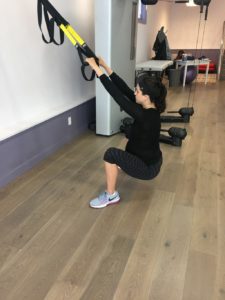 Deep Squat – the assisted deep squat is a great way to promote optimal fetal positioning, and practice fully relaxing the pelvic floor.
Deep Squat – the assisted deep squat is a great way to promote optimal fetal positioning, and practice fully relaxing the pelvic floor.
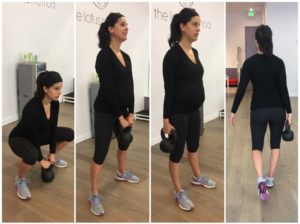 “Carseat” Carry – keeping your body stacked and not shifting, carry a moderately heavy object. It sounds simple, but this exercise is not only an excellent way to work your core (and the arm holding the weight!), but it’s a great way to prepare for carseat carrying, and lugging all those baby gifts up flights of stairs!
“Carseat” Carry – keeping your body stacked and not shifting, carry a moderately heavy object. It sounds simple, but this exercise is not only an excellent way to work your core (and the arm holding the weight!), but it’s a great way to prepare for carseat carrying, and lugging all those baby gifts up flights of stairs!
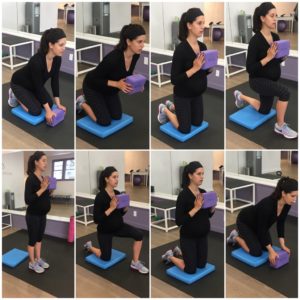 “Baby” Get-Up – Tummy time isn’t just a developmental workout for baby – it’s one of the many times mom will have to eventually pick up baby. Practicing getting up and down from the floor (or a chair, bed, etc.) without using your hands develops those mama muscles you’ll be needing!
“Baby” Get-Up – Tummy time isn’t just a developmental workout for baby – it’s one of the many times mom will have to eventually pick up baby. Practicing getting up and down from the floor (or a chair, bed, etc.) without using your hands develops those mama muscles you’ll be needing!
-
Can You? vs. Should You?
Many pregnant women will be surprised by how strong and capable their bodies feel. Our culture also tends to celebrate women who run in the Olympics during pregnancy, or who did the hardest workout they could up until their delivery date. While these things may be appropriate for some women, depending on their goals and their individual bodies, it’s not healthy, helpful, or realistic to expect yourself to be able to do alllll the things! Yes, you may be able to run at 9 months pregnant, but should you? What is the demand on your pelvic floor? Will running at 9 months pregnant potentially set you up for a more difficult recovery? Does running at 9 months pregnant prepare you for birth and beyond? Maybe, maybe not. It’s important to weigh the pros and cons of the exercise we can be doing in order to decide if it’s exercise we should be doing. Pregnancy is roughly 40 weeks of a woman’s life but the decisions she makes regarding exercise during her pregnancy can have lasting implications even after her baby is no longer little!
-
Get Help!
A woman’s body will change in the almost-10-months of pregnancy, and her workouts should, too! If you’re pregnant and hitting the gym, and feel confused about what is appropriate, or are experiencing symptoms (pain, discomfort, leaking, heaviness, etc.), make sure to reach out to a qualified pre/postnatal personal trainer, or a physical therapist specializing in women’s health.
By taking into consideration these five things, you’ll be well on your way to an active and healthy pregnancy!
*****
 Haley Shevener is a Pre/Postnatal Exercise Specialist and the Head of Methodology at The Lotus Method in San Francisco. She holds speciality certifications in pregnancy and postpartum fitness, kettlebell training, Olympic weightlifting, functional movement, and is affiliated with the Body Positive Fitness Alliance. A trainer since 2005, Haley developed a particular interest in working with pre- and postnatal women after becoming pregnant with her son. Haley believes that fitness, at its best, is a tool that helps us build better relationships with ourselves and the world around us. Her sessions enable clients to sustainably build and practice strength and function in a body-positive environment. In addition to training, Haley enjoys writing, music, and laughing and strolling the streets of SF with her husband and son.
Haley Shevener is a Pre/Postnatal Exercise Specialist and the Head of Methodology at The Lotus Method in San Francisco. She holds speciality certifications in pregnancy and postpartum fitness, kettlebell training, Olympic weightlifting, functional movement, and is affiliated with the Body Positive Fitness Alliance. A trainer since 2005, Haley developed a particular interest in working with pre- and postnatal women after becoming pregnant with her son. Haley believes that fitness, at its best, is a tool that helps us build better relationships with ourselves and the world around us. Her sessions enable clients to sustainably build and practice strength and function in a body-positive environment. In addition to training, Haley enjoys writing, music, and laughing and strolling the streets of SF with her husband and son.

















